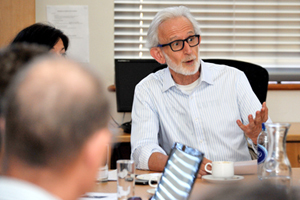Professor Martin Hall on "the violence of things"
14 March 2014 | Story by Newsroom
A 1620 painting called Judith Slaying Holofernes depicts an apocryphal scene from the Old Testament's Book of Judith in which a city, Bethulia, is saved by the beheading of a Syrian general.
The painter, Artemisia Gentileschi, didn't just depict violence; famously, she was also the subject of it: She was raped by her art tutor, and participated in pressing charges against him (although it meant being subjected to gynaecological examination and torture during the trial). Her rapist was sentenced to one year's imprisonment '“ a term he never served.
Professor Martin Hall argues in his working paper titled The Violence of Things, that the archaeology, or instrumentality, of violence '“ in this case Judith's sword '“ is under-examined.
"Despite its prevalence through art, the archive and almost every aspect of our lives, violence remains under-theorised," writes Hall. This is despite the fact that the "artefacts of violence", from ancient stone implements to modern weapons of war, are part of every aspect of the archaeological archive.
Hall, former deputy vice-chancellor of UCT and current vice-chancellor of the University of Salford in Manchester, presented his paper at seminar hosted by the Archive & Public Culture Research Initiative and the African Studies Unit on 25 February 2014.
Reframing the instruments of violence
Much of Hall's argument is based on Hannah Arendt's 1969 essay On Violence. Arendt argues that "while power and violence are always connected, the ways in which they work together is not self-evident and requires analysis".
This connection between power and violence Arendt calls "instrumentality", and Hall's mission is to deconstruct this instrumentality, so that many of our modern human actions can be better understood.
"My interest here is how violence is deployed through technology and what we can do to understand that," Hall explains.
"I want to frame that again within a concept of coloniality and decoloniality, and [in a way] that connects to a second strand of really important writing about violence, which of course comes from Frantz Fanon's Wretched of the Earth, and runs through the work of Ngũgĩ, Mbembe and Mignolo, who are writing about the way that colonialism itself is constantly saturated in violence on the body of the colonial subject.
"Whether you're looking at the violence of colonialism in, say, Namibia, or whether you're looking at the historical record of violence or slavery, you are seeing an extraordinary and constant deployment of violence."
One can't understand colonialism without understanding it as inherently linked to violence, says Hall.
But the way instruments of violence have traditionally been studied does not fully express their destructive power and effect on people and things.
Relooking the violence of language
"There is a vast material archive of violence that spans more than a million years of humanity: stone tools, swords, knife blades, arrowheads, gunflints, bullet casings, bayonets, cannonballs, battlefields, fortifications," writes Hall. Up to now, these have been studied largely in cold, clinical terms.
Gentileschi's painting, for instance, being understood as an artefact "in a complex association of power and violence", would probably not be accepted in the domain of traditional archaeology. The excavation of Richard III demonstrates this "stripping away of viscerality". The language used to describe the remains of Richard III '“ killed at Bosworth Field in 1485 and rediscovered under a British car park '“ and his cause of death "is detached, forensic and unemotional", contends Hall.
For example: "Large hole underneath back of skull. The largest injury is this hole where part of the skull has been completely sliced away ' A second potentially fatal injury, visible in the same photograph, is a jagged hole at the top of the image. A sword or similar bladed weapon has been thrust through the bone."
Richard III's death seems to have been severely painful, but the "classificatory conventions of analysis and the archive wash away the blood and pain", Hall argues.
A global phenomenon
While blades were the "instrumentality" of violence in the time of Richard III and Gentileschi, these have given way to batons, shields, teargas, guns and helicopters, says Hall, when describing the clashes between groups of youth and police in England in 2011.
Hall's archaeology of violence is founded in the instrumentality of artefacts, be they "implicated in fifteenth-century British warfare, twentieth-century juntas in Latin America, or the interrogation and torture that is part of the apparatus of the contemporary security state".
If that instrumentality is not seen as an integral part of the dispositions of power, warns Hall, it risks offering little more than fodder for the entertainment industry.
Further, Hall rejects the idea that violence is '˜normal' in the Global South.
"The rhetoric of my writing is trying to tackle an assumption that I find privileged in the [Global] North and the West: that non-violence is the state of normality, and violence is the state of normality in the [Global] South."
"I have argued here for '˜southern theory', since an understanding of coloniality and decoloniality shows how violence, and therefore its archaeology, is endemic everywhere; it is its technology and means of deployment that varies, not its presence or threat of application."
Associate Professor Nick Shepherd, head of UCT's African Studies Unit, says that Hall's paper is situated at the boundary of archaeology and material culture studies, pre-colonial and postcolonial theory, urban and African studies.
"It's one of those extraordinary works of synthesis. Martin takes ideas, theorists and studies from a wide variety of texts and brings them together in a systematic way which is quite wonderful. It's a tremendously exciting area of debate. Martin was a key figure in founding it."
Story by Yusuf Omar. Image by Raymond Botha
 This work is licensed under a Creative Commons Attribution-NoDerivatives 4.0 International License.
This work is licensed under a Creative Commons Attribution-NoDerivatives 4.0 International License.
Please view the republishing articles page for more information.










